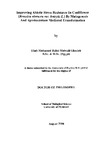Improving Abiotic Stress Resistance In Cauliflower (Brassica oleracea var. botrytis L.) By Mutagenesis And Agrobacterium Mediated Transformation
| dc.contributor.author | Gharieb, Ehab Mohamed Rabei Metwali | |
| dc.contributor.other | Faculty of Science and Engineering | en_US |
| dc.date.accessioned | 2013-02-11T09:33:23Z | |
| dc.date.available | 2013-02-11T09:33:23Z | |
| dc.date.issued | 2006 | |
| dc.identifier | Not available | en_US |
| dc.identifier.uri | http://hdl.handle.net/10026.1/1294 | |
| dc.description | Merged with duplicate record 10026.1/2333 on 14.02.2017 by CS (TIS) | |
| dc.description.abstract |
Abiotic environmental stress such as drought, salinity and low temperature are common conditions that adversely affect plant growth and crop production. Breeding for crop resistance to abiotic stress is difficult due to its multigenic nature. An alternative approach is through DNA mutation and DNA transfer. These approaches were employed and tested in this research and comparison between them was carried out. NEU and NMU induced mutant lines and control plants were sub-cultured many times on maintenance medium and stored at 5°c for 2 years and then tested for salt and hydroxyproline resistance as in-vitro and in-vivo plants and proline content was measured. Non-acclimated and acclimated in-vivo plants were also assessed for resistance to freezing. Control plants had little or no NaCI or hydroxyproline resistance whilst selected plants showed varying degrees of resistance. In-vitro and in-vivo responses of selected lines were correlated. Leaf proline content was increased markedly in the mutant lines and the greatest proline contents occurred following NaCI stress with the most respondent line having 100 fold levels compared to the controls. Both non-acclimated and acclimated selected lines showed improved frost resistance over controls. The results clearly demonstrated that NaCI, frost and hydroxyproline resistance were stable traits over repeated in-vitro subcultures and prolonged low temperature storage. A complete range of mutants with single, double or triple resistance traits were produced. The level of resistance however was not necessarily correlated with the level of proline and some lines showed resistance without elevated proline. It is concluded that elevated proline is not essential for improved resistance to abiotic stress in cauliflower, but where it does occur it does improve resistance. Integration of APX and SOD stress genes into cauliflower (Brassica oleracea var. botrytis L.) plants was achieved by using Agrobacterium tumefaciens – mediated transformation method. The procedure utilized polymerase chain reaction (PCR) amplification of insert DNA directly after isolation of individual colonies without the necessity of separate procedures for DNA isolation and purification. Preliminary selection of transgenic plants was performed on different combinations of kanamycin, gentamycin and tetracycline containing medium. Integration of the introduced stress gene (APX and SOD) in the plants was confirmed by using β-glucuronidase gene (GUS) and leaf disc assays as a gene fusion and diagnostic marker, respectively. The stable integration of the APX and SOD gene at 478 bp was detected by using polymerase chain reaction (PCR) of the putative transgenic plants. Analysis of APX and SOD gene expression under salt treatment showed that putative transgenic cauliflower survived the salinity stress comparing with the control plants. | en_US |
| dc.language.iso | en | en_US |
| dc.publisher | University of Plymouth | en_US |
| dc.title | Improving Abiotic Stress Resistance In Cauliflower (Brassica oleracea var. botrytis L.) By Mutagenesis And Agrobacterium Mediated Transformation | en_US |
| dc.type | Thesis | |
| plymouth.version | Full version | en_US |
| dc.identifier.doi | http://dx.doi.org/10.24382/4563 |
Files in this item
This item appears in the following Collection(s)
-
01 Research Theses Main Collection
Research Theses Main


